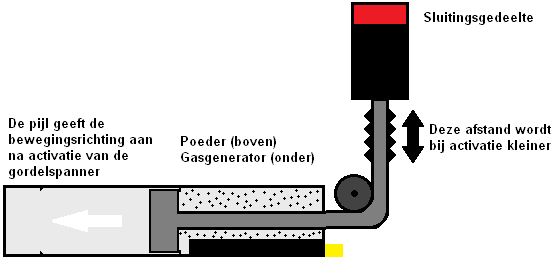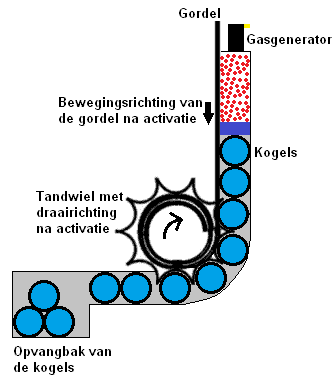Subjects:
- Belt tensioner
- Operation of the belt tensioner (2 types)
seat belt tensioner:
Nowadays, all front seat belts are fitted with a pretensioner. This belt tensioner will tighten the belt in the event of a frontal or side impact (at an angle of max. 30 degrees from the centerline of the car).
When the belt is pulled hard, the retractor will block with every construction, even the one without a belt tensioner. The belt cannot be rolled out any further. (The inertia reel should not be confused with the belt tensioner). By releasing the belt slightly again, the inertia reel is released again and the belt can then be pulled out further. This is easy to test with every seat belt in the car. This is also checked every major service and MOT. If the inertia reel does not lock, there is theoretically no point in putting on the seat belt.
In the event of a frontal or side impact (at an angle of max. 30 degrees), the vehicle will have a very large deceleration. This will cause the belt retractor to lock. This prevents the person from shooting forward and being injured. In systems with a belt tensioner, the belt is tightened even more. After a collision, an explosive device causes the buckle of the seat belt to be pulled down within 30 milleseconds. The belt is then tightened very tight. The retractor will immediately lock due to this sudden force (just like the belt is pulled with a jerk). The freedom of movement of the person in the chair is thus even smaller, so that there is even less chance of injury.
Function of the belt tensioner:
There are 2 different types of belt tensioners; namely a tensioner that is located at the closing part, or at the retractor.
Belt tensioner at the closing section:
In the event of a collision, the airbag control unit will apply a voltage to the gas generator, igniting the powder. The working piston will be fired to the left by this explosion (see picture below) and will get stuck in the left part. Because the cable is connected to both the closing portion and the working piston, the closing portion is pulled downwards along with it. The belt is therefore tightened at a distance of approximately 80mm (8cm).

Belt tensioner on the retractor:
This belt tensioner is mounted in the B-pillar (approximately next to the seat, behind the body trim). With this belt tensioner, too, a voltage is applied to the gas generator by the airbag control unit after a collision. The powder (indicated in red) will ignite. The blue plunger will push the bullets down with a lot of force. The cavities of the gear are exactly the same size as the balls. Because the balls move downwards with great force, the gear will rotate. The belt will roll up on the extended part of the sprocket. This can also be seen in the image.
Rolling up makes the belt shorter. The belt will also be rolled up about 80mm with this tensioner. This will also have happened within 30 milliseconds of the collision.

Both types of belt tensioners are unusable after activation. After they go off they will need to be replaced. Often the tensioners are constructed in such a way that the connection of 2 iron contacts is broken after they have gone off. By constantly checking the resistance values, the airbag control unit will recognize that the resistance is infinitely high. The airbag indicator lamp will illuminate and the fault will not be cleared as long as a faulty or no seat belt tensioner is fitted.
If this is not the case, it is easy to check with the first type of belt tensioner whether it has been in operation; at the end of the metal tube (in the direction the working piston moves) there will be a colored plastic cap blown off. This cap is there to check whether the tensioner has gone off. The closing part will also be a lot further down, making it more difficult to reach than normal.
